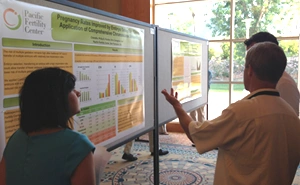
PCRS Update: Dr. Chenette's Poster
Another overview of one of the posters PFC presented at PCRS this year:
Chenette, Philip E, Pacific Fertility Center, San Francisco, CA
Chenette, David L, Chief Scientist, Lockheed Martin Advanced Technology Center, Palo Alto, CA
Multiple gestation is one of the primary risks of fertility treatment. To reduce this risk, ASRM has published criteria recommending the number of embryos transferred (which include age, cleavage stage, and prognosis). However, even when following the latest 2013 criteria, the risk of multiple gestation is still significant. Embryo implantation rate is another crucial factor to consider when evaluating this risk.
With the new lab technology that PFC has instituted, we are seeing embryo implantation rates of 60-90% with transfer of a single embryo. As embryo implantation rates improve, multiple gestation becomes a greater risk.
In working towards a solution to further reduce this risk, this research project utilizes a mathematical formula to predict multiple gestation risk at various embryo implantation rates. With this formula, we are able to model IVF outcomes in a new way. To maintain multiple gestation rates less than 5%, it is essential to perform single embryo transfer (eSET) at any implantation rate over 20%.
- Philip Chenette, MD
Categories
About the Blog
Welcome to the Pacific Fertility Center Blog! Nationally and internationally recognized for providing exceptional reproductive care, our team believes in empowering people with the knowledge they need to navigate their unique fertility journeys.
From information on the latest fertility treatments to valuable insights on egg donation, surrogacy, and everything in between, the Pacific Fertility Center Blog is your ultimate resource for all things reproductive care and support. Read on to learn more, and contact us today if you have any questions or want to schedule a new patient appointment.

